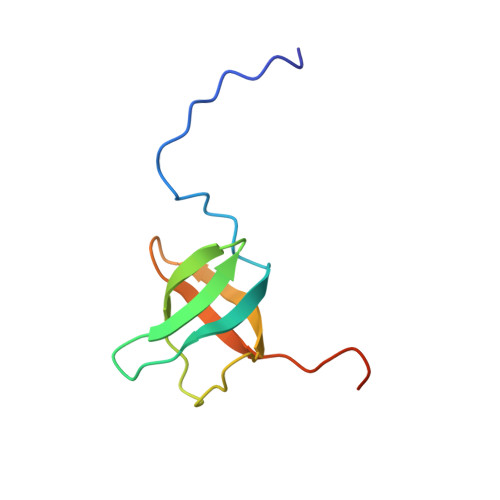The solution structure of the C-terminal domain of NfeD reveals a novel membrane-anchored OB-fold.
Kuwahara, Y., Ohno, A., Morii, T., Yokoyama, H., Matsui, I., Tochio, H., Shirakawa, M., Hiroaki, H.(2008) Protein Sci 17: 1915-1924
- PubMed: 18687870
- DOI: https://doi.org/10.1110/ps.034736.108
- Primary Citation of Related Structures:
2EXD - PubMed Abstract:
Nodulation formation efficiency D (NfeD) is a member of a class of membrane-anchored ClpP-class proteases. There is a second class of NfeD homologs that lack the ClpP domain. The genes of both NfeD classes usually are part of an operon that also contains a gene for a prokaryotic homolog of stomatin. (Stomatin is a major integral-membrane protein of mammalian erythrocytes.) Such NfeD/stomatin homolog gene pairs are present in more than 290 bacterial and archaeal genomes, and their protein products may be part of the machinery used for quality control of membrane proteins. Herein, we report the structure of the isolated C-terminal domain of PH0471, a Pyrococcus horikoshii NfeD homolog, which lacks the ClpP domain. This C-terminal domain (termed NfeDC) contains a five-strand beta-barrel, which is structurally very similar to the OB-fold (oligosaccharide/oligonucleotide-binding fold) domain. However, there is little sequence similarity between it and previously characterized OB-fold domains. The NfeDC domain lacks the conserved surface residues that are necessary for the binding of an OB-fold domain to DNA/RNA, an ion. Instead, its surface is composed of residues that are uniquely conserved in NfeD homologs and that form the structurally conserved surface turns and beta-bulges. There is also a conserved tryptophan present on the surface. We propose that, in general, NfeDC domains may interact with other spatially proximal membrane proteins and thereby regulate their activities.
- Field of Supramolecular Biology, International Graduate School of Arts and Sciences, Yokohama City University, Tsurumi, Yokohama, Kanagawa 230-0045, Japan.
Organizational Affiliation:
















